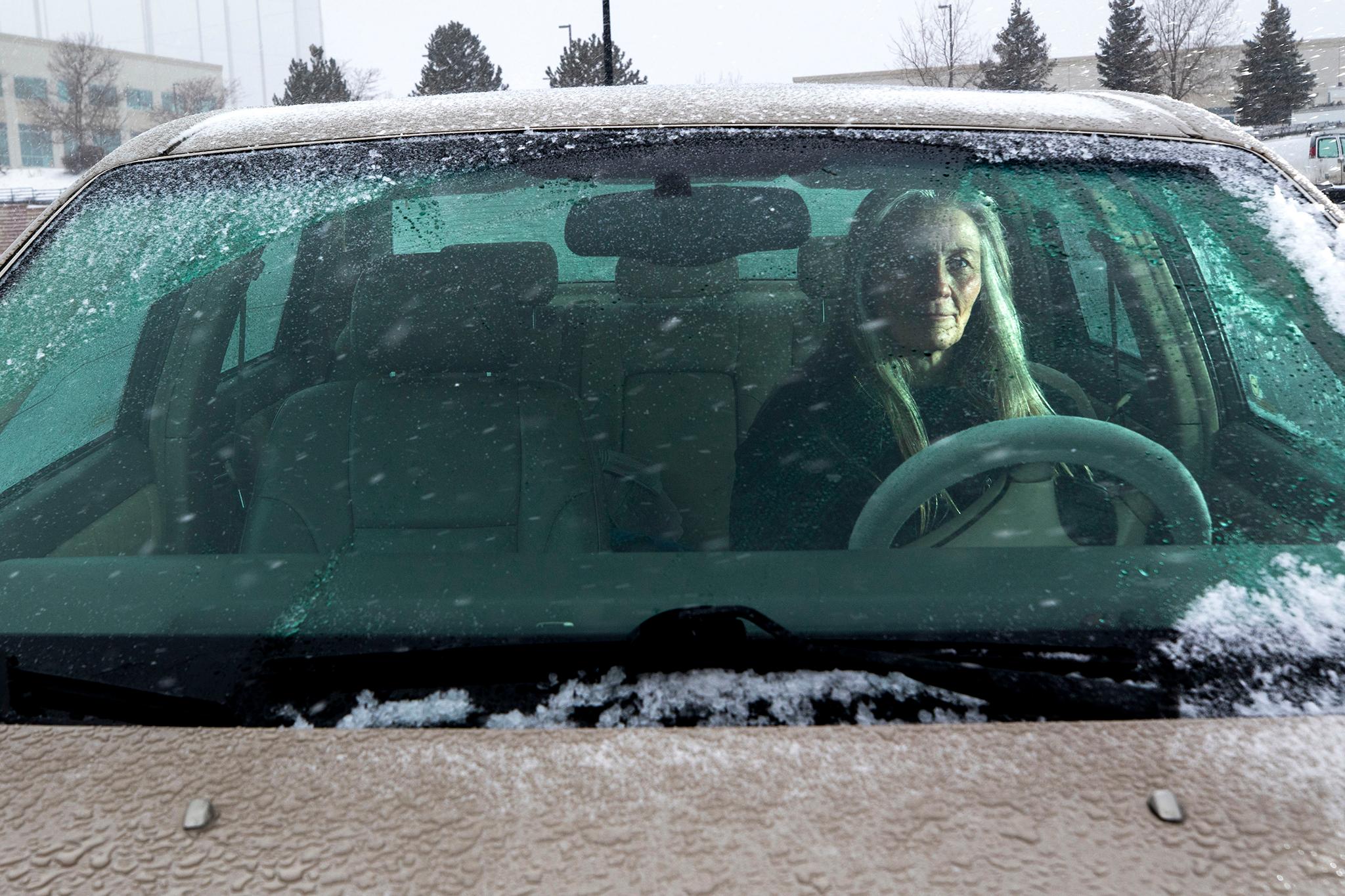
A national poll shows that three-quarters of American adults are more likely to support a candidate because he or she offers details on how to make housing more affordable. Half of Colorado’s registered voters would be more likely to vote for a state legislature candidate who supports housing funding.
And again and again amid the 2020 presidential campaign, CPR News and Denverite found voters were concerned about housing and homelessness.
“That’s good to know … that I’m not the only one,” said Sue Sanders, who was among the more than 700 people across the state who filled out a survey to guide CPR’s coverage of the presidential election.
In 2016, Sanders lost the south Denver apartment that had been her home for 14 years.
Her rent had been steadily increasing, forcing her to rely on food pantries and SNAP to eat. When the rent finally outstripped her $1,000 per month disability payments, Sanders, who has worked as an administrative assistant, at first slept in her complex’s laundry room. Then she worked as a caregiver in exchange for room and board, and later stayed with a friend.
For about two years, the lifelong Denver resident and fourth-generation Coloradan has been sleeping in her car in the parking lot of a 24-hour Walmart in Centennial. She said at least 20 other people experiencing homelessness are in the lot on any given night.
“I never thought it would happen to me,” said Sanders, who was interviewed after responding to the CPR survey. “I spent a long time early on not telling anyone. It (homelessness) was my big secret. I tell people. People need to know it goes on.”

It’s a national crisis that affects not just the poor but also middle-income earners like teachers and firefighters. Across the country, people are losing their homes or struggling to stay in them as the cost of housing increases more quickly than earnings. Some families have yet to rebound from the mortgage crisis of 2008. Cities and rural towns face housing shortages and the need to renovate the stock they do have.
Rhema Zlaten, a Colorado Mesa University journalism professor who lives on the Western Slope, has seen the crisis from both sides of the Rockies. As she was finishing up a doctorate at Colorado State University last summer, Zlaten and her husband, a systems engineer, saw they could not afford to buy a home large enough for their family of five in Longmont, where they were living at the time. They contemplated moving out of state. But Zlaten, who had grown up in Grand Junction, found her Colorado Mesa job.
Zlaten, interviewed after completing the CPR survey, said she feels lucky to have found a house she and her husband could afford in Palisade. But now she’s seeing housing prices in western Colorado creeping toward Front Range levels, though incomes are not as high. She follows a Palisade message board and sees posts from people searching for of $800 or or $900.
“And everyone’s like, 'There’s no rent like that here in town or in Grand Junction,'” she said. “It’s hard to see, and I have no clue what the answer is.”
Carol Kampf of Loveland has worked as a visiting nurse all over the country and more recently as a volunteer child advocate in the courts. She said she has seen children living in crowded, squalid housing.
“We’re supposed to be a first-world country,” Kampf said in an interview after responding to the CPR survey. “To have children living in conditions like that just strikes me as antithetical to being a first-world country.
“Look at the (housing) prices on the front range,” Kampf added. “I don’t know how anyone with any student debt can afford to rent, let alone buy.”
Steve Berg is vice president of programs and policy for the National Alliance to End Homelessness, which is part of a network that the National Low Income Housing Coalition formed to draw attention to such concerns and lobby for solutions. The network, known as Opportunity Starts at Home, last year commissioned a poll of 1,201 adults. In a letter to 2020 presidential hopefuls that accompanied the release of the survey results, Opportunity Starts at Home said that “for too long, the critical importance of safe, decent, affordable housing has been overlooked in presidential campaigns.”
“Most people in most communities are very concerned about affordability and where their kids are going to live and where the people they work with are going to live,” Berg said.
“Concern around homelessness is at a very high level,” Berg added in an interview. “There’s an immediate problem of homelessness in many places.”
It was their poll that found that 76 percent of Americans would be more likely to vote for a candidate if he or she had a detailed housing affordability plan.
The poll showed people had some ideas for what should be in such a plan, including putting more money into federal rental assistance programs such as Section 8 vouchers.
In its latest report on rent trends in the United States, the Harvard Joint Center for Housing Studies said the federal response to rising costs has fallen short for years.
“HUD budget outlays for rental assistance programs grew from $37.4 billion in 2013 to $40.3 billion in 2018 in real terms, an average annual increase of just 1.5 percent,” the Harvard housing researchers wrote. “The shortfall in federal spending leaves about three out of four of the 17.6 million eligible households without rental assistance.”
President Donald Trump’s administration has requested $41.3 billion for fiscal year 2021 to help low-income households pay the rent, saying that supports the same number of households — about 4.6 millions — now being served.
Sen. Amy Klobuchar, one of the Democrats vying to take on Trump in the general election, promises to eliminate the Section 8 backlog.
Section 8 vouchers are distributed in lotteries. Sanders has so far not had her name drawn. She is on several waiting lists for below-market rate housing. She said she was shocked when she first learned wait lists can be years long.
“At my age, in five years, I could be dead,” said Sanders, who is 61. “You can die waiting for housing. On a housing list.”

Don Burnes, founder of the Colorado Center on Law and Policy’s Burnes Institute of Poverty Research, said local and state governments can subsidize and build affordable housing.
But at the local level, “we are woefully short of having the kinds of resources that are necessary,” Burnes said. “If you look at funding mechanisms, if you look at the tax systems, if you look at dollars for research and you look at persuading the private sector to do more, I think the feds could play a much stronger role than they have have.
“To think that we would recreate a war on poverty is probably beyond any realistic expectation,” Burnes said. “But we haven’t won the war.”
Sen. Elizabeth Warren has proposed spending $500 billion over 10 years to build, preserve and renovate homes for lower-income families. She says she’d pay for it by lowering the threshold at which the wealthy have to pay estate taxes to $7 million from $22 million and raise tax rates on “ultra-millionaires and billionaires.”
Sen. Bernie Sanders — no relation to Sue Sanders — has proposed investing $1.48 trillion over 10 years in the Housing Trust Fund, which was created at the start of the mortgage crisis of the early 2000s to ensure the poorest Americans could rent housing.
Teo Nicolais, a landlord, real estate educator and consultant for the Apartment Association of Metro Denver, has questions for candidates such as Warren and Sanders:
“How much are you spending total on rental assistance and on building new housing?” Nicolais said. “It comes down to spending and priorities.”
But Nicolais said spending was not the only federal tool that could make a difference, pointing to low-income housing tax credits. Developers who are awarded credits sell them to investors for cash they then use to build. State agencies — in Colorado it's the Colorado Housing and Finance Authority — distribute state and federal tax credits on a competitive basis. In Colorado, state legislators last year voted to double the annual aggregate cap from $5 million to $10 million that can be distributed in state low-income housing tax credits beginning this year through 2024. Former New York Mayor Mike Bloomberg’s housing plan includes a promise to expand federal low-income housing tax credits.
The low-income housing tax credit program has “been described as the most successful affordable housing solution that no one has ever heard of,” Nicolais said.
“It does something which many other programs or policies don’t do: It incentivizes the creation of new housing,” Nicolais said. “Over the long term, the construction of any new housing helps with affordability.”
Karen Kallenberg, executive director of Habitat for Humanity of Colorado, also is thinking about solutions beyond spending. She said her organization, which relies on donations and labor to keep prices down on the for-sale housing it builds, and other affordable developers “have historically been impacted by overly restrictive zoning, drawn-out approvals processes and high permitting fees.” She wants to know what presidential candidates would do at the federal level to encourage more state and local government to revise zoning codes to make it easier for her to build.
A Joe Biden administration would tie new federal investments in housing to a requirement that states and localities eliminate regulations that reduce the availability of affordable housing and contribute to sprawl. The former vice president pledges to direct his secretaries of Housing and Urban Development and Transportation to identify existing federal grant programs that can be amended to add zoning reform requirements.
Cathy Alderman, vice president of communications and public policy for the Colorado Coalition for the Homeless, said many candidates have housing plans. They post their ideas on their websites, but they somehow don’t become part of the political conversation, she said.
“I don’t think we’ve really talked about housing since the New Deal,” Alderman said.
Alderman’s advocacy and service organization last year commissioned a survey of 500 registered voters across Colorado, taking particular pains to include millennial and rural voters. That survey found that 54 percent of Colorado voters said support for housing funding would make them more likely to vote for a candidate for state legislature.
Boulder homeowner Blair Norman, who works for a company that produces secure storage bags for marijuana, prescription medicine and other items that need to be kept safe at home, kept a friend from experiencing homelessness by taking her in while she looked for housing.
“I have friends who say they have to move out of Boulder because they can’t afford it,” she said. “And you see the homeless people everywhere.”
Norman, who was interviewed after responding to the CPR survey, said voters shouldn’t be expected to comb through candidates’ Web sites searching for their proposals on housing.
Candidates need to highlight such issues “rather than the feuds between people,” Norman said.
A look at what candidates are saying about housing:
Trump’s 2021 budget proposal includes $47.9 billion for the Department of Housing and Urban Development. The bulk of that $47.9 billion is $41.3 billion for rental assistance. Also in the total is $2.8 billion earmarked to help local and state governments fund emergency shelters and others services for people experiencing homelessness. Trump in 2019 named HUD Secretary Ben Carson head of a new White House Council on Eliminating Barriers to Affordable Housing, which is charged with identifying regulations that add to the costs of home construction.
On homelessness, a 2019 report from the president’s Council of Economic Advisers signaled a shift, portrayed the housing-first approach as providing “housing with no preconditions or service participation requirements after people are stabilized.” Soon after that report was released, Trump appointed Robert Marbut executive director of the U.S. Interagency Council on Homelessness. Marbut has stressed that services like mental health care and drug rehabilitation must be a requirement for housing those experiencing homelessness.
Biden’s housing plan has a price tag of $640 billion over 10 years. He proposes funding the Section 8 program so that everyone eligible gets rental assistance. Biden also has proposed a tax credits for renters and to help first-time home buyers make down payments. He would expand a program that helps first responders, teachers and others buy homes if they commit to living in struggling communities. Biden showed willingness to embrace others’ ideas, including a proposal by Rep. James E. Clyburn of South Carolina and former presidential candidate and Colorado Sen. Michael Bennet to ensure tenants facing eviction have legal assistance. Biden also endorsed a bill by California Rep. Maxine Waters to spend $13 billion over five years on case management, shelters, housing vouchers and more than 400,000 housing units for people experiencing homelessness. Biden has endorsed housing-first.
Bloomberg says that under his administration 4 million more low-income families would get rental assistance. He’s also offering federal grants to entice cities to implement eviction-prevention programs. He addresses wage stagnation in his housing plank — the fact that housing costs have risen much faster than wages is often pointed to as a key driver of the housing crisis. Bloomberg proposes raising the minimum wage to $15 an hour. He would increase federal spending on homelessness programs from the under $3 billion in the Trump budget to $6 billion a year.
Buttigieg has promised to spend $170 billion to ensure that all eligible families with children receive housing vouchers and services. He says he will end homelessness for young people and for families with children. He also has promised to spend $430 billion on affordable housing and other steps to bring down housing costs. He says he will use low income housing tax credits and other tools to get more than 2 million more units of affordable housing built or restored.
Klobuchar includes students in her housing plan. She says she would double the maximum Pell Grant — which can be used for housing and certain other non-tuition expenses — to $12,000 per year and expand eligibility to families with annual incomes of up to $100,000. She would introduce personal savings accounts that can be tapped in emergencies such as falling behind on the rent. Employers would bank at least 50 cents per hour to help workers build these savings accounts. Overall, Klobuchar has promised to spend more than $1 trillion on housing and poverty reduction.
Sanders would put $1.48 trillion over 10 years into the Affordable Housing Trust Fund, a federal program launched in 2016, to build, rehabilitate, and preserve the 7.4 million units he estimates America needs to eliminate its affordable housing gap. He also would spend $70 billion to repair and modernize public housing. He has called for a national cap on annual rent increases of 3 percent or 1.5 times the Consumer Price Index, whichever is higher. He’s proposed $50 billion over 10 years to provide grants to start and expand community land trusts.
Warren has put at the center of her housing plan a piece of legislation she introduced in the Senate. Her American Housing and Economic Mobility Act. It calls for spending $500 billion over 10 years to build, preserve, and renovate housing lower-income families can afford. She says the supply her plan will create will reduce rents by 10 percent over the 10 years. Warren also proposes helping homeowners who are still underwater from the 2008 financial crisis. She would spend $2 billion to support underwater borrowers.









